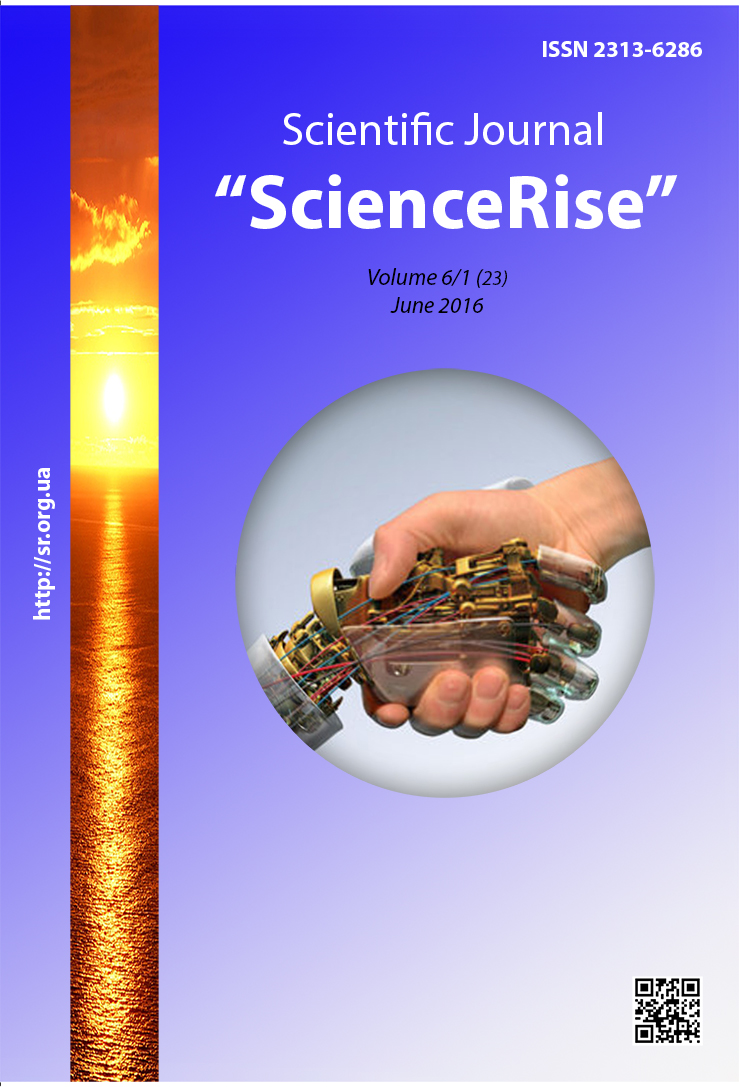Heat and mass transportation as factor of formation abnormally high stratum pressure (on the example of the east part of Dniper-Donets cavity)
DOI:
https://doi.org/10.15587/2313-8416.2016.72705Keywords:
tectonic fault, heat and mass transportation, abnormally high stratum pressure, anomalies, hydrocarbons, inversionAbstract
On the example of the eastern part of the Dnieper-Donets cavity (DDC) considered the role of the heat and mass transportation in the Earth's crust as a factor of the formation of abnormally high stratum pressure (AHPS). Investigated the regularity of the spatial distribution geochemical and positive anomalies of thermal field as indicators of AHPS zones.
Established restriction sites abnormally-high reservoir pressure to areas of deep faults activated and drawn schematic map of the distribution of abnormally high reservoir-ticks
References
Suyarko, V. G., Zagnitko, V. M., Ly`sy`chenko, G. V. (2010). Strukturno-geoximichni kry`teriyi prognozuvannya skupchen` vuglevodniv (na pry`kladi Zaxidno-Donecz`kogo grabenu). Kyiv: Salyutis, 83.
Ljal'ko, V. I., Mitnik, M. M. (1986). Teplomassoperenos v geologicheskih processah. Geologicheskij zhurnal, 46 (6), 80–86.
Ljal'ko, V. I., Mitnik, M. M., Dobrovol's'kij, E. V. (1982). Novye reshenija zadach teplomassoperenosa dlja celej geologii. Geologicheskij zhurnal, 42 (3), 13–24.
Mitnik, M. M. (1980). Vlijanie vertikal'noj fil'tracii podzemnyh vod na temperaturu pripoverhnostnyh slojov. Dokl AN USSR. Ser. B, 23–25.
Belokon', V. G. (1981). O glubinnom istochnike ugleobrazovanija formacii Doneckogo bassejna. Geologicheskij zhurnal, 6, 88–99.
Kapshur, Ja. M. (1986). O konduktivnom potoke tepla iz nedr Jugo-Zapadnogo Donbassa. Spepankosvskie chtenija, 48–52.
Krivosheja, V. A., Pashova, N. T., Eremin, V. I. (1998). Geotermobaricheskoe pole DDV. Nafta і gaz Ukrayni, 13–14.
Lukin, A. E. (2004). Glubinnaja gidrogeologicheskaja inversija kak global'noe sinergeticheskoe javlenie: teoreticheskie i prikladnye aspekty. Geologicheskij zhurnal, 4, 53–70.
Zinenko, I. I., Zarickij, A. P. (2011). Osnovnye polozhenija koncentracii genezisa i metodiki prognozirovanija anomal'no vysokih plastovyh davlenij v sisteme teplomasoperenosa. Vіsnik HNU іmenі V. N. Karazіna, 956, 20–31.
Novosilecij, R. M. (1984). Pozdnij katagenez – zona generacii fljuidov s AVPD. Neftjanaja i gazovaja promyshlennost', 4, 17–21.
Orlov, A. A. (1981). Analiz vlijanija tektonicheskogo faktora na velichiny plastovyh davlenij v zalezhah uglevodorodov Ukrainy. Geologija nefti i gaza, 2, 48–52.
Tereshhenko, V. A. (2015). Gidrogeologicheskie uslovija gazonakoplenija v Dneprovsko-Doneckoj vpadine. Kharkov: HNU imeni V. N. Karazina, 244.
Kropotkin, P. N. (1986). Degazacija Zemli i genezis uglevodorodov. Zhurnal Vsesojuz. Him. O-va im. D. I. Mendeleeva, 5, 540–547.
Suyarko, V. G., Istomin, O. M. (2005). Do py`tannya pro mozhly`vi pry`chy`ny` formuvannya gidrokarbonatno-natriyevy`x vod u gly`boky`x gory`zontax paleozoyu. Dop. AN Ukrayiny`, 116–144.
Kmet', A. A., Lukin, A. E., Strelec, G. A. (1981). Litologicheskie i geohimicheskie kriterii prognozirovanija AVPT v paleozojskih otlozhenijah. Geologicheskij zhurnal, 6, 127–131.
Sujarko, V. G. (2006). Geohimija podzemnyh vod Vostochnoj chasti Dneprovsko-Doneckogo avlakogena. Kharkov: Izd. Har'kovskogo un-ta, 225.
Voznyak, D. (2007). Mikrovklyuchennya ta rekonstrukciya umov endogennogo mineraloutvorennya. Kyiv: Naukova dumka, 279.
Fil'kin, V. A. (1968). Opyt sostavlenija karty sovremennyh dvizhenij zemnoj kory po teritorii Donbassa. Sovremennye dvizhenija zemnoj kory. Kyiv: Nauk. dumka, 221.
Downloads
Published
Issue
Section
License
Copyright (c) 2016 Vasily Suyarko, Liliya Ishchenko, Alexander Yashchenko, Yuliya Yakimenko

This work is licensed under a Creative Commons Attribution 4.0 International License.
Our journal abides by the Creative Commons CC BY copyright rights and permissions for open access journals.
Authors, who are published in this journal, agree to the following conditions:
1. The authors reserve the right to authorship of the work and pass the first publication right of this work to the journal under the terms of a Creative Commons CC BY, which allows others to freely distribute the published research with the obligatory reference to the authors of the original work and the first publication of the work in this journal.
2. The authors have the right to conclude separate supplement agreements that relate to non-exclusive work distribution in the form in which it has been published by the journal (for example, to upload the work to the online storage of the journal or publish it as part of a monograph), provided that the reference to the first publication of the work in this journal is included.

